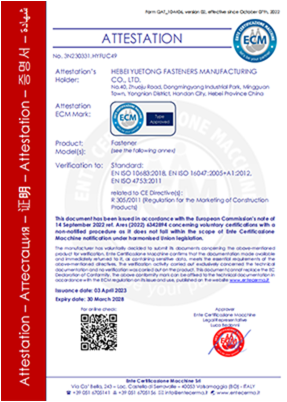Out . 31, 2024 04:53 Back to list
how to choose screw size
How to Choose the Right Screw Size
Choosing the right screw size is crucial for ensuring the integrity and safety of any project, whether you’re working on furniture assembly, construction, or DIY crafts. The right screw not only secures the items together but also prevents damage to materials. Here’s a guide on how to choose the right screw size for your needs.
1. Understand Screw Dimensions
Screws are measured by their diameter and length. The diameter is categorized into gauge sizes, with smaller gauge numbers indicating thicker screws. Length is measured from the top of the head to the tip of the screw. When selecting a screw, both dimensions matter.
2. Determine the Material to be Fastened
Different materials require different types and sizes of screws. For example, wood screws differ from metal screws in terms of thread design and point shape. If you’re fastening wood, choose wood screws with sharp tips and coarse threads. For metal, use machine screws with a finer thread. Additionally, consider the thickness of the material; a thicker material will require longer screws to ensure a secure hold.
3. Consider the Load Requirements
When choosing screw size, consider the load or stress it needs to bear. Heavier items necessitate larger, thicker screws for added support. For lighter materials or items, smaller screws will suffice. Take into account not just the weight of the item being fastened but also any dynamic forces it may be subject to, such as vibration in machinery or the pull of a drawer.
how to choose screw size

4. Account for the Thickness of the Materials
The screw should ideally penetrate through the first material and into the second material without poking out excessively on the other side. A good rule of thumb is to have at least half of the screw's length embedded in the second material. For example, if you are joining a 1-inch thick board to another and the screw needs to go ½ inch into the second board, a 1.5-inch screw would be a suitable choice.
5. Choose Appropriate Head Types
Screw heads come in various designs, including flat, round, pan, and hex. The choice of head affects how the screw is driven and whether it can be countersunk for a flush finish. For visible applications, a decorative head might be more suitable. For structural applications, a flat or round head may be best for secure fastening.
6. Use the Right Tools
The screw's size should also be compatible with your driving tools. Ensure you have the proper drill bits and drivers for the screws you choose. Using the wrong tool can strip the screw head or damage the material.
Conclusion
Choosing the right screw size encompasses more than just picking one off the shelf; it requires an understanding of the materials, load requirements, thickness, and head type. By carefully considering these factors, you can select screws that will provide a strong, durable hold, ensuring the success of your project. Whether you’re a seasoned professional or a beginner, following these guidelines will lead you to make the right choices for your fastening needs.


